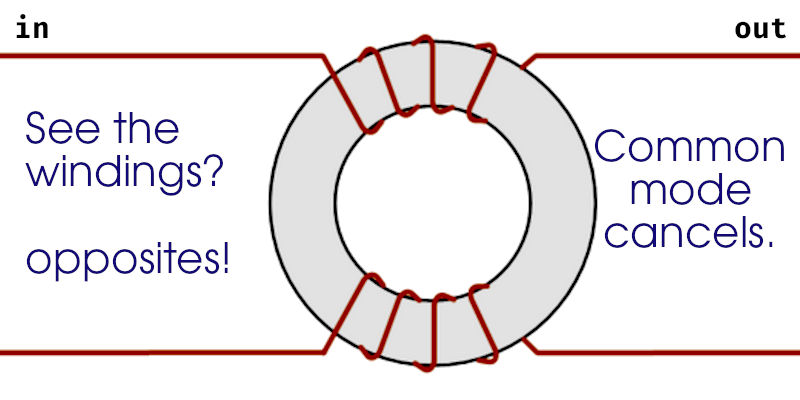If you want your antennas to perform up to their theoretical design specifications, your sensitive radios to actually receive weak signals, or your amplifiers to work without causing chaos in other devices, you should become familiar with the construction and usage of RF chokes in general, and more specifically with common mode chokes.
The problem solved very nicely by common mode chokes is radiation and pickup of RF energy by the antenna feedline. You may have noticed the phenomonon if you live close to a strong mediumwave or shortwave broadcast station. I once lived close to station WGY in upstate, New York, and their news and voice would get into my audio and radio equipment, even when I was careful to shield and ground my devices well. In addition, I was often plagued by noise from light dimmers, power supplies, and video screens. It turned out that blocking the RF traveling down the antenna feedline in common mode reduced the noise by several decibels, uncovering all sorts of desirable weak signals I could not previously receive.
Common mode noise is noise induced in the feedline by radio frequency electromagnetic fields, not coupled into the feedline ends at the antenna or radio connection. RF fields impinging on the feedline induce currents in it such that the noise in both conductors is in phase. For example, an oscilloscope check of the shield and center conductor of a coaxial cable would show the noise waveform exactly in phase on both, though many dB stronger on the shield. Normal signals in a coaxial cable would be in differential mode, absolutely not in phase. The good news is that common mode RF is removable with high inductance chokes placed at one or both ends of the feedline. Ferrite chokes work well for VLF through HF bands, while air core coaxial chokes work well at VHF and above.
What you will notice in the videos and construction projects you may find for common mode chokes is the peculiar winding directions on the ferrite cores. It is important, as the windings are oriented such that the magnetic fluxes from common mode signals will add, thereby suppressing passage through the filter. Fluxes from differential mode signals cancel, so the signal passes through.

Common Mode Chokes VLF through HF
My suggestion, balancing performance against price is a size 240 core (2.4 inch diameter) with a type 31 ferrite mix. These are plentiful, reasonably priced, and work well.The simplest, most crude application is to wind several turns of coaxial cable through a core, with only a couple of inches remaining at the end for connection to the antenna. Likewise, also wind several turns around a core at the transmitter end of the feedline. It works, but any budding radio operator should use a better construction method.
I am impressed by the handiwork of Paul Cianciolo, W1VLF, for these RF chokes. He builds them with a length of coaxial cable, with connectors, and mounts everything in a sturdy plastic box which can last for decades. See his video embedded below:
Note that you are not limited to one core. Multiple cores may be stacked for higher inductance. If you don't mind the higher expense, however, go for the larger cores with the best possible ferrite mix. This is more important on the upper frequencies in the HF spectrum.
Common Mode Chokes VHF and Above
Ferrite cores do not perform so well at higher frequencies. For VHF and higher frequencies, it is more effective to use an air core choke. This usually consists of several turns of an electrical one wavelength coaxial cable on a plastic or fiberglass form.
As wavelengths get shorter, it is necessary to be more precise in handling connections. Keep the lead lengths short, neatly clipped, and neatly soldered! Coaxial cable quality and electrical length become critical too, so calculate carefully, cut carefully, and test your work. The video calls for a one wavelength cable section, as it is ideally transparent to the equipment. It should not cause much of an impedance bump, except for a little due to the connectors.
You can change to better / thicker cable, which will change the inner diameter of the coil. Some operators do use much better cable and refuse to have a PVC form in the coil. That is a more purist approach; I would suggest a fiberglass or carbon fiber form if you do not want to wrap on a PVC form.
Reducing RF Noise and Interference from Computers and Appliances
While we are discussing chokes, know that you can quiet the RF junk in a noisy home or office by winding the USB, ethernet, mouse, monitor, and power cables through common mode chokes as used for your HF lines. Wind several turns of cable through a ferrite core; do it at both ends for long video or ethernet cables. Certain thick cables do not bend very well around toroid cores; use clip-on chokes for them, on each end of the cable. If both ends cannot be filtered, apply chokes to the end connected to the computer.
Build Your Library of RFI / EMI Reduction
For more tips and projects for reducing RFI, I suggest the excellent K9YC publications which cover the whole spectrum of interference reduction. In particular, download the pdf book RFI, Ferrites, and Common Mode Chokes For Hams and for more VHF and UHF help, go get VHF-UHF Chokes. Chuck Counselman, W1HIS, has published a guide any ham or shortwave listener should have, simply titled Common-Mode Chokes. These are some of the best guides available anywhwere, and they free.
© 2005 - 2025 AB9IL.net, All Rights Reserved.
Written and curated by Philip Collier / AB9IL.
About Philip Collier / AB9IL, Commentaries and Op-Eds, Contact, Privacy Policy and Disclosures, XML Sitemap.